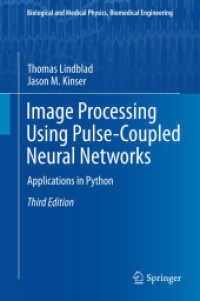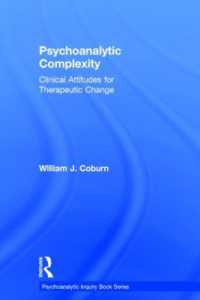- ホーム
- > 洋書
- > 英文書
- > Psychology
Full Description
From the beginning of psychoanalysis, there have been those considered suited to psychoanalytic therapy and those not. Those 'suited' could dream and associate as well as understand and accept the analyst's symbolic interpretations. Those 'unsuited' were either unreceptive to treatment or were psychotic and it was feared that analysis could worsen an already fragile situation.
Throughout his decades of clinical experience, Franco De Masi expanded his work to treat patients considered difficult to analyse. By doing so, he went beyond the territory of the dynamic unconscious into territory where psychic processes outside awareness reside. This inspiring book outlines his journey in two parts. Part I looks at certain aspects of traditional therapeutic work for 'analysable' patients. De Masi discusses the relationship between psychoanalytic theories and models; how the analytic perspective of childhood life has changed over the past few decades; the concept of psychic truth; the duration of therapy; analytic therapy in old age; and the concept of the superego. Part II looks beyond the dynamic unconscious and highlights the existence of mental states inaccessible to traditional psychoanalytic methods. Here, De Masi investigates the psychotic mind and unknown spaces.
Building on the revolutionary roots of psychoanalysis, De Masi broadens psychoanalytic practice to include psychic suffering hitherto considered unreachable. Case studies throughout the book illustrate the psychoanalytic theory, making it the ideal read for practising clinicians looking to expand their practice and academics interested in the efficacy of psychoanalysis.
Contents
Contents
About the author
Introduction
Part I: Within the territory of the dynamic unconscious
1. Models and theories in psychoanalysis: a radical hypothesis
2. Psychopathology: returning to the roots
3. The competent child
4. The meaning of the analytic relationship
5. The concept of truth in psychoanalysis
6. Protracted analyses
7. Psychotherapy at an advanced age
8. The supergo: from a structuring element to an invasive object
9. Perversion as a sexualised withdrawal
Part II: Beyond the territory of the dynamic unconscious
10. The dynamic unconscious and intuitive thought
11. Patients who do not dream
12. The power of alternative realities
13. Outside awareness
14. Unrepresentability
15. The foreclosure of the Name-of-the-Father
16. My research on psychosis
17. Towards a broader view of supervision
18. Concluding reflections
References
Index






